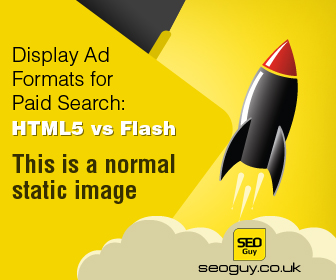Here we take a look at these alternative formats and their pros and cons, and explain why we believe that HTML5 is the best solution.
Mobile use overtakes computers
Obviously you want everybody to be able to view your display ads irrespective of the device they are using, however this isn’t as straight forwards as you might think. The problem is that Flash is no longer supported for Android devices, and has never been supported by Apple for a variety of reasons; neither is it supported by Microsoft for their Windows phones. This is a big problem, and over recent times it has been getting bigger.
For several years mobile usage for accessing the internet has been growing rapidly at the expense of computers. In May 2015 Google announced that more searches are now made using mobile devices such as tablets and smartphones than are made using a computer. This followed a previous Google announcement that mobile friendly websites will be favoured in their search engine results served to mobile devices, and that sites that are not mobile friendly will be downgraded.
Also, statistics published by eMarketer suggest than during 2015 UK adults will spend more time accessing media using a mobile device than they will with a PC. The same source indicated that on average people will spend 2 hrs 26 min on a mobile and 2 hrs 13 min on a PC or laptop. In the US mobile has been dominant for some time.
Clearly these trends will continue, and in the future it will become increasingly important to target mobile in all your advertising campaigns.
What’s wrong with Flash?
Adobe Flash has been around for many years. Essentially a platform for creating multimedia applications, Flash files are viewed in browsers using the proprietary Flash Player and in apps using Adobe AIR. It has a long history of being the primary format for displaying advertising content on the web and in apps.
Flash is almost ubiquitous on the web. Supported by just about all browsers, it is by far the most used format for viewing web videos and playing web based games. Over 80% of the most popular websites use Flash somewhere, so why is it no longer supported on mobile devices?
There are several reasons. Steve Jobs refused to support Flash from the start, claiming that it was power hungry and had several security vulnerabilities; there were also commercial considerations. So it has never been available for Apple iPhones and tablets. It was supported by earlier versions of the Android OS, but has not been for several years. It was Adobe that made the decision to drop support for mobile Flash.
Furthermore, recent changes to Google’s Chrome browser made in September 2015, ostensibly to improve its performance, mean that Flash content that isn’t considered ‘central’ to the website will be paused with the user being provided with a click-to-play button. This could have a big impact on Flash ads, especially if, as anticipated, other browsers follow suit.
Is HTML5 the answer?
The alternative to Flash is HTML5. This format has many advantages. It is supported by all modern smartphones and tablets; it is also supported by most browsers, though admittedly not to the same extent on all of them. So choosing either Flash or HTML5 implies some sort of compromise, but as we shall show, there is far more to be gained with HTML5 than there is to be lost.
HTML5 has been slowly evolving for several years, though the final HTML5 Full Specification wasn’t published until October 2014. HTML5 offers many advantages over previous versions of the language, but the most important of these in our current context is its ability to handle multimedia content without the need for proprietary plug-ins.
Gains and losses
- Apart from its compatibility with mobile, some of additional gains to be enjoyed by using HTML5 for your banner ads are:
File size – compared with Flash, HTML5 files serving the same content are tiny - Multiple screens and responsive websites – the current trend is the ability to serve content that is appropriate to the user’s device. With HTML5 you can create responsive banner ads that look great on a large monitor and on a smartphone screen.
- Dynamic ads – with HTML5 it is easy to create dynamic ads that can be changed in real time; for instance you can update price information, special offers, stock levels, and so forth.
- Accessibility – HTML5 can be used by accessibility tools such as screen readers, for instance to serve audio data to the visually impaired.
However Flash has some advantages:
Not every place where you might want to place a banner ad will necessarily accept HTML5; though that is likely to change in the future.
With Flash you can be certain that the ad will appear as you built it, but there is the potential for a little more variability with HTML5. For instance, certain fonts may appear slightly differently in different browsers. It’s not a big problem but some testing is advised to ensure that it will appear as you want it to in every browser.
What about PNG and GIF?
PNG and GIF are ideal formats for static ads. In certain environments static ads may even have a higher click through rate. They can also be used as a fall-back position where other formats fail.
Animated GIF ads certainly have a place; they are widely used and viewable on all devices. If you use the full 256 colour palette to its best benefit, they can also look great. However compared to FLASH and HTML5, they lose out as they lack the interactivity and the real professional touch of Flash and HTML5.
Verdict
We believe that we have shown that the future for banner ads is almost certainly HTML5. Flash has served us well in the past, but the signs are that it is losing ground as the dominant format. Maybe its days are numbered; please let us know what you think.
So where do we go from here? Following are a few suggestions about converting your Flash ads to alternative formats. We also examine what these alternative formats look like.
Next steps
- Since February 2015 Google has been converting Flash ads to HTML5 automatically to make it easier to reach mobile users and other non-users of Flash on the Google Display Network. However not all Flash ads convert satisfactorily, in fact many don’t. (You can check this with the Swiffy Flash to HTML converter).
- However, even if Flash ads can be processed with Google’s Flash to HTML5 converters, it is really placing your campaign at Google’s mercy. A far better approach is to ask your graphics designers to supply you with the Ads in multiple formats such as PNG, GIF, Flash & HTML5 which they have created and thoroughly tested.
- Using multiple formats is also the best option for running your campaigns on third party ad servers.
Try it yourself
The best way to discover the difference between the various file formats is to try them out for yourself. We have created a range of ads in animated PNG, animated GIF, Flash and HTML5 formats.
 |
Static Image
This is a static add produced as a PNG. This is potentially much better quality that a JPEG file. The reason is that while JPEGs use lossy compression, PNG compression is lossless. If you are unable to see the animation to the left (or Above the “Static Image” title if you are on a mobile device) then it demonstrates PNG images cannot be viewed on your device) |
 |
Animated Gif Image
This animated GIF file consists of a series of frames that are placed in sequence in an endless loop. The total pallet is limited to 256 colours, but if used well excellent results can be obtained. The problem with GIF ads is that they are not interactive. If you are unable to see the animation to the left (or Above the “Animated Gif Image” title if you are on a mobile device) then it demonstrates Animated GIF images cannot be viewed on your device) |
If you can read this text, it means the Flash file cannot be displayed on your device. |
Flash Image This Flash ad combines interactivity and high quality graphics to produce a smooth effect that is extremely easy on the eye. Such ads interact with the audience and encourage them to engage with the content and message. If you are unable to see the animation to the left (or Above the “Flash Image” title if you are on a mobile device) then it demonstrates Flash cannot be viewed on your device) |
| HTML5 Image HTML5 is now replacing Flash in many instances, particularly for mobile media. How do you consider the quality of this HTML5 file compares to the Flash file? Check it out on your mobile devices too. If you are unable to see the animation to the left (or Above the “HTML5 Image” title if you are on a mobile device) then it demonstrates HTML5 images cannot be viewed on your device) |

